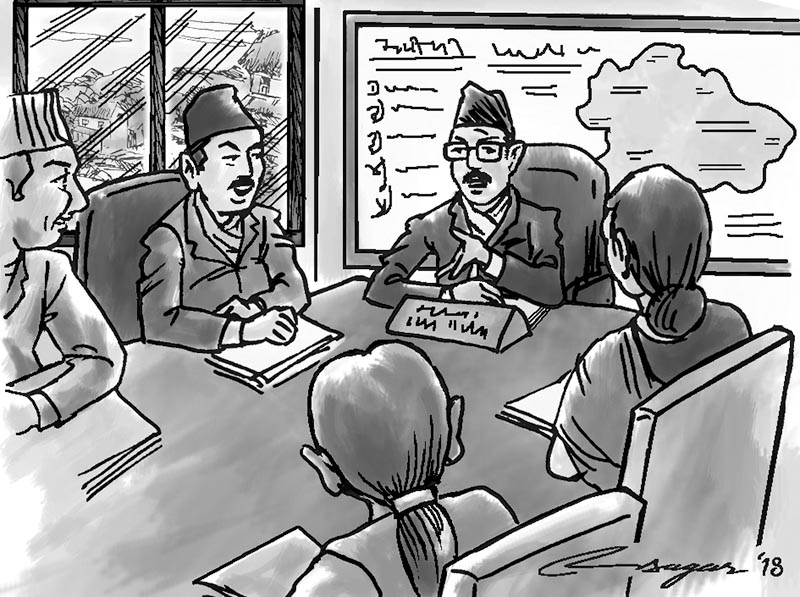District discourse: DCCs’ role in changed context
The District Coordination Committee is a component of local government, and it is not a separate or additional tier of government. The DCCs can play an important role in the overall governance system in the federal system
Elections for all three levels of government have been completed now. The process to implement an entirely new system of local, provincial and federal governments has just about started, which will take some time to complete. In that process, some degree of confusion and certain misunderstandings are but naturally expected until the new governance structures and associated infrastructure are finalised and established.
One area where more confusion is likely is related to the status of district level of local government. Prior to the promulgation of the constitution in 2015, the District Development Committee (DDC) was the dominant level of local government. This arrangement largely continued until the local elections that were held from May through September.
Post-election some people — including those from the government, non-government agencies and diplomatic communities — were erroneously claiming that a district as an entity was no longer functioning. In some cases, there were even claims that district [level government system] no longer existed and their relevance was gone. These claims are profoundly incorrect, as the district level is explicitly mentioned in the Constitution of Nepal 2015 and its roles and responsibilities have been outlined in details in the “Local Government Operations Act (LGO Act) 2017.
The confusion regarding the current status of district is somewhat understandable as during the first Constitutional Assembly (CA), it was decided that districts would be completely removed from then proposed structure of governance. Since the first CA process failed to draft the constitution, a second CA was elected to complete the job of drawing up the new constitution.
The second CA, which finally drafted the constitution, decided, albeit at the last minute, to retain districts as part of Nepal’s new governance structure. But that also did not clear the confusion until the LGO Act was introduced later in 2017. The LGO Act has specified functions and responsibilities of district and district level governance. It is clear that, from the legal standpoint, district level today remains a wholly legitimate part of local government in Nepal, albeit in a new form with an updated, and it would be fair to say reduced, set of roles and responsibilities.
As per the decentralisation agenda, the municipalities (rural municipalities, sub-metropolitan cities and metropolitan cities) are now the primary policy-making and decision-making local government bodies with greater power and autonomy. District level’s updated mandate is coordination and monitoring. This change is also reflected in the change of name from “District Development Committees” (DDCs) to “District Coordination Committees” (DCCs).
Some of the key functions delegated to the DCCs in the LGO Act include “coordination and management of development and construction, monitoring of works, coordination with all levels of government as well as the private and NGO sectors, monitoring of development plans, conflict management, coordination of disaster management efforts and maintaining balanced development”.
It is also worth noting that the DCCs are mandated to carry out any additional works as required by the provincial governments. The LGO Act also says that the federal and provincial governments “shall work in coordination with the DCCs”. Whether continuing the district [level government] was a right move is still debated, with some expressing views that it was not needed, saying that district level is redundant and its presence would result in duplication of roles that would be played by provinces.
In reality, the roles and responsibilities of the DCCs are completely different from those of provinces. A DCC is a component of local government, and it is not a separate or additional tier of government. The DCCs can play an important role in the overall governance system.
Let’s examine the make-up of the district assemblies and geographic scale of district. Firstly, the DCC works on behalf of the District Assembly and implements the decisions of the assembly. The District Assembly is made up of mayors, chairpersons and other senior elected officials of all municipalities in the district, making for a logical regional collaboration body for all local governments in that district to collaborate.
The District Assembly elects a maximum nine-member District Coordination Committee (DCC) to work on behalf of the District Assembly, including members of minority communities. The DCC fundamentally has coordination and monitoring power within and among the local units as well as district-based provincial and federal offices.
Secondly the geographic scale of the 77 DCCs provides for a simple and pragmatic solution to the coordination issues between and among the three tiers of government, as it is much simpler a proposition. Directly negotiating all policy directives with all 753 local units can be an onerous task.
The district level of local government continues to function and hopefully it will be able to grow and provide its crucial coordination and monitoring mandate as outlined by the Local Government Operations Act 2017.
Neupane & Garde work in the field of local governance




